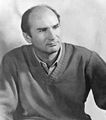He was born in 1911 in Krasnodar, Caucasus (South Russia). His family moved to Greece in 1923. He studied at the Athens School of Fine Arts (1928) and at Konstantinos Parthenis’ studio (1932-1936). He taught briefly at his father’s dancing school and in order to support himself financially, he entered into photography and graphic arts. At the same time he participated in Panellinious and other group exhibitions as a painter. In 1937 he became a member of the art group Eleftheroi Kallitechnes (Free Artists).
During the Occupation, he participated in the resistance and, in 1944 he followed the rebels on the mountains of Viniani and Agrafa. The subjects he painted at that time (scenes from the famine of Athens and the rebels’ everyday life in the mountains), were later used as sources for some of his large painting compositions.
After Greece’s liberation he started working on woodcuts and linocuts. He created many monotypes and experimented with new oxidation techniques on zinc and copper. A significant amount of his work is based on the potential of printmaking. He published albums and illustrated calendars by printing the impressions directly from the matrices. In 1950 he became a member of the art group Stathmi and in 1957 he presented his first solo exhibition in Athens (Parnassus literary society), which was his only one until 1977.
From the mid-1960's onwards, he lived mainly in Rhodes, where among other things he created murals for hotels, portraits and decorations for public buildings, while he completed many monumental compositions, based on older works. He even invented a technique that allowed him to combine printmaking with painting.
Landscape painting, influenced largely by K. Parthenis, forms a large part of his oeuvre. However, his most distinctive subject matters are inspired by social struggles and the life of the working class. These are often compositions of multiple figures facing the canvas, solid design and restricted palette.
The majority of his solo exhibitions were held abroad. In the early years of the dictatorship (1967-1970), his major touring solo exhibition was presented in 25 cities of the former Soviet Union, but he could not attend it due to a prohibition on leaving the country. His oeuvre was also presented in Italy (Livorno, 1973 and Ferrara, 1974). He participated in the Alexandria Biennale (1963) and many other group exhibitions and international painting and printmaking fairs all over the world (London, Cairo, Geneva, Leipzig, Birmingham, New York, etc.). His first retrospective exhibition was held at the Athens National Art Gallery in 1977. Three smaller retrospective exhibitions followed after his death (Athens, 1983), and a major one was held at the Benaki Museum in 2012.
Semertzidis Valias (1911 - 1983)





